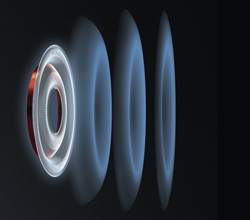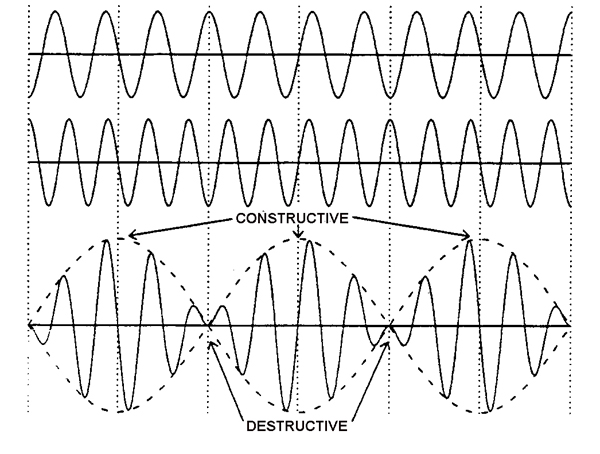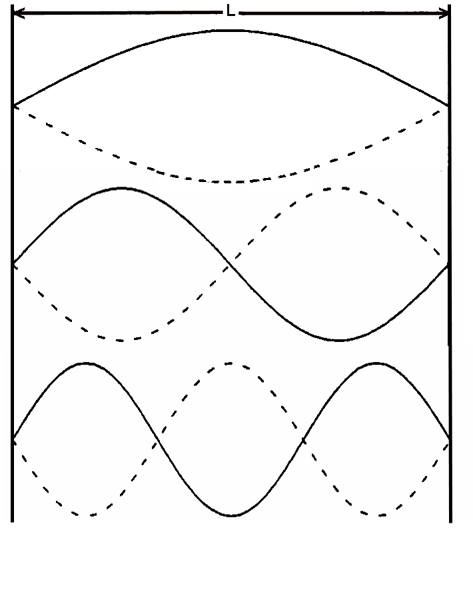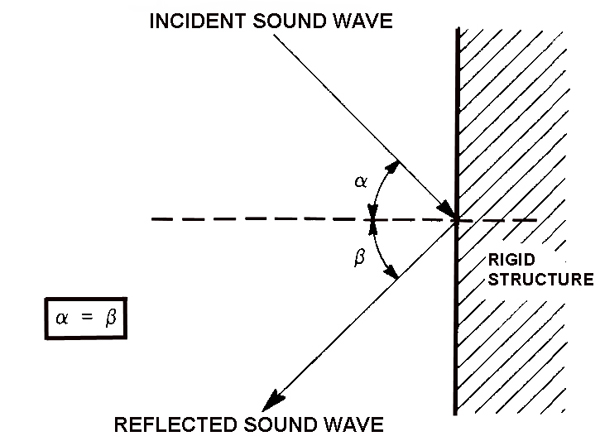
JUST BEAT IT
One interesting wave addition phenomenon is that of beats. Beats occur when two sinusoids of slightly different frequency, typically less than 15 Hz apart, combine at a point in space.
Because the two waves have slightly different frequencies, they will have varying phase relationships, resulting in times when the waves are partially in-phase and partially out-of-phase with each other.
Thus, the waves will add constructively and destructively resulting in slowly varying amplitude.
For example, if the two frequencies are 220 and 229 Hz, the sinusoids will be in-phase and interfere constructively 9 times per second and be out-of-phase 9 times per second, and interfere destructively. The sound level will vary from loud to soft at a rate of 9 Hz.
Most people can perceive beat frequencies up to about 15 Hz. Beyond this value the sensation of “roughness” occurs with no beating. Further separation of the two sinusoids results in perceiving each as a separate frequency. This is one basis for determining the critical bandwidths of the ear.
Figure 3 shows the generation of a beat frequency.

When a sound wave approaches a boundary surface, a portion of the incident energy is reflected and a portion is absorbed by the surface. The absorbed sound is the sum of the dissipated losses within the boundary medium and the portion transmitted through the boundary.
The characteristic impedance of the boundary surface determines the ratio of absorbed sound to incident sound. The physical density of architectural materials is higher than air and results in most of the sound energy being reflected away from the boundary surface.
Two broad classes of sound reflections can occur: standing waves and specular reflections. Standing waves are the result of the law of superposition. Specular reflections are not based on the law of superposition. The sound absorption mechanism described above is applicable to both standing waves and specular reflections.
Standing waves result from interference of two or more waves that repeatedly pass through each other when traveling back and forth between the room boundaries. The result is a wave that appears stationary having regions of maximum amplitude (antinodes) and minimum amplitude (nodes).
ON THE SURFACE
For rooms, the standing waves are referred to as room modes. Three types of room modes occur: axial, tangential, and oblique. Each room mode type is supported by an increasing number of room surface pairs.

Axial modes require two opposite room surfaces (one pair); tangential modes require four room surfaces (two pairs); and oblique modes require six room surfaces (three pairs).
Axial modes are the most audible. The tangential and oblique modes are respectively 6 and 12 dB less than the axial modes. Figure 4 shows axial standing waves (room modes).
A specular reflection occurs when the incident angle from the incoming wavefront at the boundary surface equals to the reflected angle from the boundary. This reflection phenomenon only occurs when the wavelength of the incident sound is less than approximately one-fourth the boundary surface dimension.
For the above conditions, the reflections can be approximated as rays and laws of geometrical optics apply. Figure 5 shows simple specular reflection. The wavelength for low frequency sound is often equal to or larger than the room dimensions. When this occurs, there are no specular reflections, and wave acoustics is used for analysis.

One key concept to remember when sound is incident at a physical boundary is the particle velocity (v) and acoustic pressure (p) are 90° (π/2 radians) out-of-phase with each other. At a boundary, the particle velocity will be zero and the pressure will be a maximum.
This is important when considering sound absorption of materials: the maximum absorption at the lowest frequency of interest will occur at a distance equal to λ/4 from the boundary. At this distance the particle velocity will be a maximum for the frequency corresponding to λ/4. Since most “acoustical” materials are frictional absorbers, a maximum particle velocity will result in the greatest sound absorption.
Resonance is the reinforcement of sound by synchronous vibration. Every object in nature has a “preferred” or “natural” frequency at which the object will vibrate. Imposing an oscillatory force of the same frequency as the object’s natural frequency will cause the object to vibrate at maximum amplitude will little energy input from the exciting force. Changing the “forcing” frequency by a small amount will effectively decrease the resonant response.
